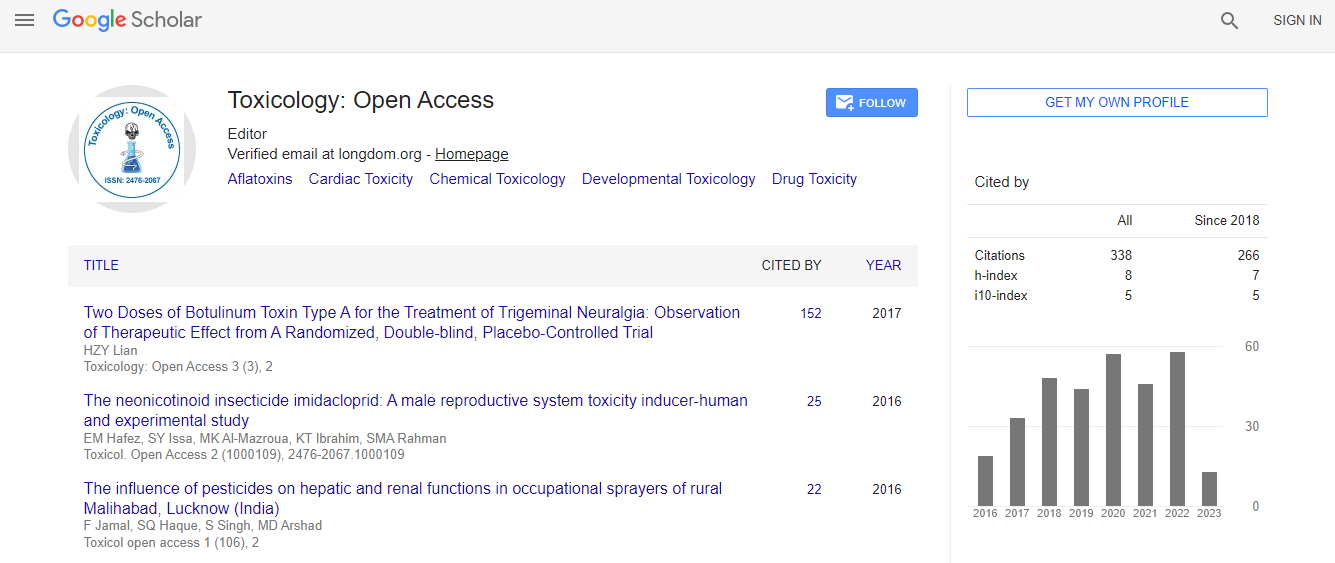Our Group organises 3000+ Global Conferenceseries Events every year across USA, Europe & Asia with support from 1000 more scientific Societies and Publishes 700+ Open Access Journals which contains over 50000 eminent personalities, reputed scientists as editorial board members.
Open Access Journals gaining more Readers and Citations
700 Journals and 15,000,000 Readers Each Journal is getting 25,000+ Readers
Google Scholar citation report
Citations : 336
Toxicology: Open Access received 336 citations as per Google Scholar report
Indexed In
- Google Scholar
- RefSeek
- Hamdard University
- EBSCO A-Z
- Geneva Foundation for Medical Education and Research
- Euro Pub
- ICMJE
Useful Links
Related Subjects
Share This Page
Anti-photoaging effects of ammonium glycyrrhizate in UVB-irradiated HaCaT keratinocytes and UVA-irradiated human dermal fibroblasts
14th World Congress on Toxicology and Pharmacology
Byung-Mu Lee, Seung Eun Lim and Hyo Sun Suh
Sungkyunkwan University, South Korea
Posters & Accepted Abstracts: Toxicol Open Access
Abstract
Among many environmental factors, solar ultraviolet irradiation is considered the main cause of skin aging in humans. In this study, the protective effect of ammonium glycyrrhizate (AG), an active component of Licorice root, on UVA- and UVB-induced photo-toxicity was investigated. The antioxidant phytochemical AG has been reported to have various pharmacological properties including cardio-protective, anti-inflammatory and soothing effects on sensitive skin. Despite the known therapeutic effect of AG, the molecular mechanisms related to the photo-protection of AG against UV-induced oxidative cell damage has not yet been determined. In UVB-irradiated HaCaT keratinocytes, AG inhibited both oxidative stress and the apoptosis signaling pathway. In addition, AG promoted the activities of the antioxidant enzymes heme oxygenase-1 (HO-1), glutathione peroxidase 1/2 (Gpx1/2) and superoxide dismutase 2 (SOD2) by translocating nuclear factor (erythroid-derived 2)-like 2 (Nrf2) in the nucleus. In UVAirradiated human dermal fibroblasts, AG suppressed the expression of secreted matrix metalloproteinase (MMP)-1 and -9 by inhibiting the activator protein-1 (AP-1) transcription factor. Furthermore, AG remarkably increased the synthesis of procollagen in human dermal fibroblasts (HDF). These results suggest that AG has protective effects against UVA and UVBinduced photoaging and should be considered a potential therapeutic agent against photo-toxicity in skin. Recent Publications 1. Kyu-Bong Kim, Young Woo Kim, Seong Kwang Lim, Tae Hyun Roh, Du Yeon Bang, Chang Won Park, Hyung Sik Kim, Byung-Mu Lee (2017) Toxicological and risk assessment of zinc oxide nanoparticles, a cosmetic ingredient used as a UV filter in sunscreens. J. Toxicol Environ Health Part B.; 20(3): 155-182. 2. Min Ji Kim, Seung Jun Kwack, Seong Kwang Lim, Yeon Joo Kim, Tae Hyun Roh, Seul Min Choi, Hyung Sik Kima, Byung Mu Lee (2015) Toxicological evaluation of isopropylparaben and isobutylparaben mixture in Sprague-Dawley rats following 28 days of dermal exposure. Regul. Toxicol. Pharmacol.; 73(2): 544-51.Biography
Byung-Mu Lee has his expertise in development of anti-aging and anti-inflammation agents. He is also interested in chemoprevention and risk assessment. He is an Associate Editor of the Journal of Toxicology and Environmental Health A, Food and Chemical Toxicology and Editorial Review Board of Environmental Health Perspectives (EHP) and Advisory Editor of Archives of Toxicology. He was the Vice President of International Association of Environmental Mutagenesis and Genomics Society (IAEMGS) and Vice President of the Asia Society of Toxicology (ASIATOX).
Email:bmlee@skku.edu

 Spanish
Spanish  Chinese
Chinese  Russian
Russian  German
German  French
French  Japanese
Japanese  Portuguese
Portuguese  Hindi
Hindi 